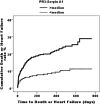Proteinase 3 and prognosis of patients with acute myocardial infarction
- PMID: 20942801
- PMCID: PMC2999885
- DOI: 10.1042/CS20100366
Proteinase 3 and prognosis of patients with acute myocardial infarction
Abstract
A multimarker approach may be useful for risk stratification in AMI (acute myocardial infarction) patients, particularly utilizing pathways that are pathophysiologically distinct. Our aim was to assess the prognostic value of PR3 (proteinase 3) in patients post-AMI. We compared the prognostic value of PR3, an inflammatory marker, with an established marker NT-proBNP (N-terminal pro-B-type natriuretic peptide) post-AMI. We recruited 900 consecutive post-AMI patients (700 men; age, 64.6±12.4 years) in a prospective study with follow-up over 347 (0-764) days. Plasma PR3 was significantly higher in patients who died [666.2 (226.8-4035.5) ng/ml; P<0.001] or were readmitted with heart failure [598 (231.6-1803.9) ng/ml, P<0.004] compared with event-free survivors [486.9 (29.3-3118.2) ng/ml]. Using Cox modelling, log10 PR3 [HR (hazard ratio), 3.80] and log10 NT-proBNP (HR, 2.51) were significant independent predictors of death or heart failure. When patients were stratified by plasma NT-proBNP (median, 1023 pmol/l), PR3 gave additional predictive value for death or heart failure, in both the patients in whom NT-proBNP level was above the median (log rank for trend, 12.54; P<0.0004) and those with NT-proBNP level below the median (log rank for trend, 3.83; P<0.05). Neither marker predicted recurrent AMI. In conclusion, this is the first report showing a potential role for the serine protease PR3 in determining mortality and incidence of heart failure following AMI, independent of established conventional risk factors. PR3 may represent a clinically useful marker of prognosis after an AMI as part of a multimarker strategy.
Figures


References
-
- Libby P., Theroux P. Pathophysiology of coronary artery disease. Circulation. 2005;111:3481–3488. - PubMed
-
- Friedman G. D., Klatsky A. L., Siegelaub A. B. The leukocyte count as a predictor of myocardial infarction. N. Engl. J. Med. 1974;290:1275–1278. - PubMed
-
- Naruko T., Ueda M., Haze K., van der Wal A. C., van der Loos C. M., Itoh A., Komatsu R., Ikura Y., Ogami M., Shimada Y., et al. Neutrophil infiltration of culprit lesions in acute coronary syndromes. Circulation. 2002;106:2894–2900. - PubMed
-
- Buffon A., Biasucci L. M., Liuzzo G., D'Onofrio G., Crea F., Maseri A. Widespread coronary inflammation in unstable angina. N. Engl. J. Med. 2002;347:5–12. - PubMed
-
- Fu X., Kassim S. Y., Parks W. C., Heinecke J. W. Hypochlorous acid oxygenates the cysteine switch domain of pro-matrilysin (MMP-7). A mechanism for matrix metalloproteinase activation and atherosclerotic plaque rupture by myeloperoxidase. J. Biol. Chem. 2001;276:41279–41287. - PubMed
Publication types
MeSH terms
Substances
Grants and funding
LinkOut - more resources
Full Text Sources
Medical
Research Materials

